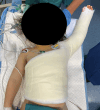Coracohumeral Ligament Sectioning in Teres Major versus Latissimus Dorsi Tendon Transfer in Brachial Plexus Birth Palsy
- PMID: 40538415
- PMCID: PMC12178672
- DOI: 10.1055/a-2618-3151
Coracohumeral Ligament Sectioning in Teres Major versus Latissimus Dorsi Tendon Transfer in Brachial Plexus Birth Palsy
Abstract
Background: The latissimus dorsi tendon transfer (LDTT) to the supraspinatus tendon is a common procedure for restoring shoulder abduction and external rotation in upper root brachial plexus lesions. However, its association with scapular retraction often limits shoulder abduction.
Methods: This retrospective study compared the functional outcomes of teres major tendon transfer (TMTT) combined with anterior coracohumeral ligament release (CHLR) versus LDTT. Patients who underwent surgery at our center between January 2012 and December 2022 were included, with a mean follow-up of 38 months. Outcomes were assessed using a range of motion and the Mallet scale.
Results: A total of 40 patients were included, with 20 undergoing TMTT with CHLR and 20 undergoing LDTT. The overall mean age was 3.9 years (range: 2.7-4.8), with mean ages of 3.4 years (range: 2.2-5.2) in the LDTT group and 4.1 years (range: 2.8-5.2) in the TMTT with the CHLR group. The TMTT with CHLR group achieved mean gains of +77 degrees in active abduction, +44 degrees in active external rotation, and +46 degrees in passive external rotation. In comparison, the LDTT group demonstrated gains of +46, +27, and +24 degrees, respectively, for the same parameters.
Conclusion: TMTT combined with anterior CHLR significantly improves shoulder abduction and external rotation in patients with Brachial plexus birth injury, particularly those with internal rotation contractures. This technique offers superior functional outcomes compared to LDTT, suggesting a more effective therapeutic alternative.
Level of evidence: IV, retrospective comparative study.
Keywords: brachial plexus birth injury; coracohumeral ligament; latissimus dorsi; tendon transfer; teres major.
The Author(s). This is an open access article published by Thieme under the terms of the Creative Commons Attribution License, permitting unrestricted use, distribution, and reproduction so long as the original work is properly cited. ( https://creativecommons.org/licenses/by/4.0/ ).
Conflict of interest statement
Conflict of Interest None declared.
Figures



Similar articles
-
Single versus double tendon transfer for improving shoulder function in brachial plexus birth palsy: a meta-analysis of comparative studies.BMC Musculoskelet Disord. 2025 Jun 3;26(1):554. doi: 10.1186/s12891-025-08803-9. BMC Musculoskelet Disord. 2025. PMID: 40461996 Free PMC article.
-
Clinical outcomes of fully arthroscopic latissimus dorsi and teres major transfer for the treatment of posterior-superior irreparable rotator cuff tears.J Shoulder Elbow Surg. 2025 Apr 26:S1058-2746(25)00343-X. doi: 10.1016/j.jse.2025.03.023. Online ahead of print. J Shoulder Elbow Surg. 2025. PMID: 40294813
-
Better functional outcomes and a lower infection rate can be expected after superior capsular reconstruction in comparison with latissimus dorsi tendon transfer for massive, irreparable posterosuperior rotator cuff tears: a systematic review.J Shoulder Elbow Surg. 2023 Apr;32(4):892-906. doi: 10.1016/j.jse.2022.11.004. Epub 2022 Dec 14. J Shoulder Elbow Surg. 2023. PMID: 36528222
-
Split Latissimus Dorsi Tendon Transfer for External Rotation in Obstetrical Brachial Plexus Injury.Tech Hand Up Extrem Surg. 2025 Aug 21. doi: 10.1097/BTH.0000000000000533. Online ahead of print. Tech Hand Up Extrem Surg. 2025. PMID: 40830865
-
Reverse shoulder arthroplasty with isolated latissimus-dorsi transfer/additional teres-major transfer for combined loss of elevation and external rotation: A systematic review and meta-analysis.J Orthop. 2024 Oct 28;63:48-57. doi: 10.1016/j.jor.2024.10.035. eCollection 2025 May. J Orthop. 2024. PMID: 39553840 Review.
References
-
- Waters P M, Smith G R, Jaramillo D. Glenohumeral deformity secondary to brachial plexus birth palsy. J Bone Joint Surg Am. 1998;80(05):668–677. - PubMed
-
- Mallet J. Obstetrical paralysis of the brachial plexus. II. Therapeutics. Treatment of sequelae. Priority for the treatment of the shoulder. Method for the expression of results. Rev Chir Orthop Repar Appar Mot. 1972;58 01:1166–168. - PubMed
-
- Hoffer M M, Phipps G J. Closed reduction and tendon transfer for treatment of dislocation of the glenohumeral joint secondary to brachial plexus birth palsy. J Bone Joint Surg Am. 1998;80(07):997–1001. - PubMed
-
- Hoffer M M, Wickenden R, Roper B. Brachial plexus birth palsies. Results of tendon transfers to the rotator cuff. J Bone Joint Surg Am. 1978;60(05):691–695. - PubMed
-
- Allard R, Fitoussi F, Azarpira M R, Bachy M, Grimberg J, Le Hanneur M. Shoulder internal rotation contracture in brachial plexus birth injury: proximal or distal subscapularis release? J Shoulder Elbow Surg. 2021;30(05):1117–1127. - PubMed
LinkOut - more resources
Full Text Sources
Research Materials

